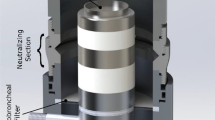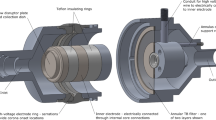Abstract
Several potential replacements for chlorofluorocarbons (CFCs) in metered-dose inhalers (MDIs) are flammable. The flammability hazard associated with their use was assessed using a range of MDIs containing 0–100% (w/w) n-butane (flammable) in HFC-134a (nonflammable) fitted with either 25-, 63-, or 100-µl metering valves or continuous valves. In flame projection tests each MDI was fired horizontally into a flame, and the ignited flume length emitted from the MDI was measured. Flame projections of ≥60 cm were produced by all formulations fitted with continuous valves which contained ≥40% (w/w) n-butane in HFC-134a. Using metering valves the maximum flame projection obtained was 30 cm. This was observed with a formulation containing 90% (w/w) n-butane in HFC-134a and a 100-µl valve. For a particular formulation, smaller metering valves produced shorter flame projections. Because many MDIs are used in conjunction with extension devices, the likelihood of accidental propellant vapor ignition was determined in Nebuhaler and Inspirease reservoirs and a Breathancer spacer. Ignition was predictable based on propellant composition, metered volume, number of actuations, and spacer capacity. Calculated n-butane concentrations in excess of the lower flammability limit [LFL; 1.9% (v/v)] but below the upper flammability limit [UFL; 8.5% (v/v)] were usually predictive of flammability following ignition by a glowing nichrome wire mounted inside the extension device. No ignition was predicted or observed following one or two 25-µl actuations of 100% n-butane into large volume Nebuhaler (750 ml) or Inspirease (660 ml) devices. Additionally, several other formulations containing lower proportions of n-butane also remained nonflammable, due to failure to reach the LFL. In the small-volume Breathancer spacer (140 ml), nonflammability was usually due to n-butane exceeding its UFL. In this situation further dilution during respiration could result in a flammable mixture. Using a carefully selected propellant blend, metering volume, and spacer design, environmentally acceptable flammable propellants may have considerable utility in MDIs reformulated without CFCs.
Similar content being viewed by others
REFERENCES
R. N. Dalby and P. R. Byron. Metered dose inhalers containing flammable propellants—perspectives and some safety evaluation procedures. Pharm. Tech. 15(10):54–66 (1991).
S. Zakhari. Propane (Chap. 4), Butane (Chap. 5), and Isobutane (Chap. 6). In L. Goldburg (ed.), Non-Fluorinated Propellants and Solvents for Aerosols, CRC Press, Boca Raton, FL, 1977, pp. 49–72.
S. Zakhari and D. M. Aviado. Cardiovascular toxicology of aerosol propellants, refrigerants and related solvents. In E. W. Van (ed.), Cardiovascular Toxicology, Raven Press, New York, 1982, pp. 281–326.
J. J. Daly, Jr. Properties and toxicology of CFC alternatives. Aerosol Age February:26 (1990).
Revised flammability test methods for aerosol products. In Aerosol Guide, 7th ed., Chemical Specialties Manufacturers Association, Inc., Washington, DC, 1981, pp. 13–23.
Code of Federal Regulations, Part 49 (Transportation), Section 173.306, Government Printing Office, Washington, DC, October 1990.
Physicians Desk Reference, 45th ed., Medical Economics Co., Oradell, NJ, 1991.
P. R. Byron. Aerosol formation, generation and delivery using metered systems. In P. R. Byron (ed.), Respiratory Drug Delivery, CRC Press, Boca Raton, FL, 1990, p. 173.
A. R. Clark, G. Rachelefsky, P. L. Marson, M. J. Goldenhersh, and A. Hollingworth. The use of reservoir devices for the simultaneous delivery of two metered-dose inhaler aerosols. J. Allergy Clin. Immunol. 85(l):75–79 (1990).
N. I. Sax and R. J. Lewis, Sr. (eds.). Dangerous Properties of Industrial Materials, 7th ed., Vols. I–III, Van Nostrand Reinhold, New York, 1989.
Material Safety Data Sheet (MSDS) on Dymel A Aerosol propellant (E-97118-1), Du Pont Company, Wilmington, DE, 1989.
Material Safety Data Sheet (MSDS) on Dymel 152a Aerosol propellant (E-94824-1), Du Pont Company, Wilmington, DE, 1989.
Product Safety Data Sheet on HCFC-141b, Allied Signal, Inc., Morristown, NJ, 1989.
Author information
Authors and Affiliations
Rights and permissions
About this article
Cite this article
Dalby, R.N. Prediction and Assessment of Flammability Hazards Associated with Metered-Dose Inhalers Containing Flammable Propellants. Pharm Res 9, 636–642 (1992). https://doi.org/10.1023/A:1015850026577
Issue Date:
DOI: https://doi.org/10.1023/A:1015850026577




